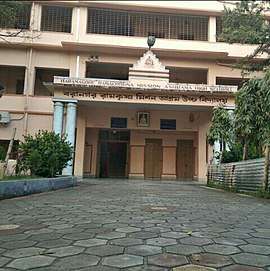Kolkata Circular Railway
Kolkata Circular Railway is a railway loop line operated by the Eastern Railway zone of Indian Railways, encircling the entire city of Kolkata.
A local train at Bagbazar railway station | |
| Overview | |
| Type | Commuter rail |
| System | Kolkata Suburban Railway |
| Locale | Kolkata |
| Termini | Dum Dum Junction Majerhat |
| Stations | 20 |
| Services | Dum Dum-Majerhat and Majerhat-Bidhannagar Road |
| Website | Eastern Railway |
| Operation | |
| Opened | 1984 |
| Owner | Indian Railway |
| Operator(s) | Eastern Railway |
| Character | At grade and elevated |
| Depot(s) | Kolkata Majerhat |
| Rolling stock | EMUs |
| Technical | |
| Line length | 38.8 km (24 mi) |
| Number of tracks | 2 |
| Track gauge | 1,676 mm (5 ft 6 in) Broad gauge |
| Electrification | 25 kV overhead line |
| Operating speed | up to 100 km per hour |
Service
The line begins and terminates at Dum Dum Junction, with a total of 19 stations spread over the route's 35 kilometers length. Services on the line are operated as an extension of the Kolkata Suburban Railway, partially sharing tracks with the Sealdah South lines, terminating at Sealdah railway station (which is bypassed by the Circular Railway). There are no services which operate throughout the loop as a whole; instead, services are operated from Dum Dum Junction to Majerhat (via Burrabazar) and Majerhat to Dum Dum Junction (via Ballygunge Junction). The line operates a part of longer suburban services from Budge Budge, Canning, Barrackpore, Hasnabad, Kalyani, Naihati etc.
The Circular Railway offers direct interchange points with the Kolkata Metro at Dum Dum Junction. The loop line serves Kolkata railway station, one of the major intercity stations in Kolkata, as well as a number of prominent city landmarks including Prinsep Ghat and Eden Gardens. In addition, a 3.7 km (2.3 mi) long line connecting Dum Dum Cantonment to the Netaji Subhash Chandra Bose International Airport became the first such suburban railway line in India to serve an airport and allowed extended Circular Railway operations from Dum Dum Junction and beyond. However, the poorly-patronized branch line between Dum Dum Cantonment railway station and Biman Bandar railway station is replaced by Line 4 (under construction) of the Kolkata Metro, which follows the same route.[1]
History
With the population of the Kolkata metropolis continuing to grow, and road transport being unable to cope with demand due to bottlenecks on the roads, it was felt necessary to introduce an additional method of transportation which would ease the congestion problem particularly at peak hours. Of the various modes considered, including tramcars and buses, the railway was found to be most suitable. Unlike other metropolitan cities, Kolkata does not have a rail route running through the heart of the city, nor through the central district area where more commuters will be seeking their transport.
Previously a railway line existed between Dum Dum railway station to Ultadanga for the transport of wagons to Chitpur Goods Yard. For a considerable time, lines ran between B.B.D. Bagh and Majerhat for the transport of goods from the port area to the godowns (warehouses) of the Calcutta port along the Hooghly River. These were built during the early East Indian Railway Company (EIR) period when the river Hooghly was navigable to this area. Gradually with the silting of Hooghly, and its inaccessibility to bigger ships, these lines ceased to be used. With these existing lines being rehabilitated and small stretches of new track being laid in a few locations, a connection could be established between Dum Dum Junction and Prinsep Ghat along the bank of the Hooghly.
The original line was a single-line track with loading and unloading sidings and wharfs. A few platforms were built and simultaneous reception facilities were constructed at some stations. The line was commissioned from Dum Dum railway station to Prinsep Ghat on 16 August 1984. In fact the lines from the port of Calcutta already existed for an interchange yard for Eastern Railways, and these lines were modified/extended/realigned for the Circular Railway. Previously the trains were hauled by diesel shunters. The electrification works have been completed and four Electrical Multiple Unit (EMU) trains originally destined for Sealdah during office hours have been diverted to the central business district of Kolkata directly, avoiding Sealdah station. The line has been an overwhelming success with commuters and the earnings have quadrupled with the introduction of EMUs. Once connected to Majerhat a train can easily ply up to Dum Dum to complete the circle. This has been a boon to office-goers. The Circular Railway is directly managed by the Eastern Railway. The Circular Railway is a part of the Kolkata Suburban Railway along with the Kolkata Metro to provide connectivity throughout the city. The line is a single-lined track from Tala station to Princep Ghat station, but in the platform area it becomes double-lined for crossing. From Princep Ghat the line becomes single-tracked until it reaches Majerhat.
Stations
List of Kolkata Circular Railway stations in anti-circular way:
| # | Station Name | Connections | Picture | Notes | ||
|---|---|---|---|---|---|---|
| English | Bengali | Code | ||||
| (a) | Dum Dum Cantonment | দম দম ক্যানটনমেন্ট | DDC | |||
| 1 | Dum Dum Jn. | দম দম জংশন | DDJ |  |
||
| 2 | Patipukur | পাতিপুকুর | PTKR | – | ||
| 3 | Kolkata | কলকাতা | KOAA | – | Major railway station of Eastern Railway | |
| 4 | Tala | টালা | TALA | – | ||
| 5 | Bagbazar | বাগবাজার | BBR |  |
||
| 6 | Sovabazar Ahiritola | শোভাবাজার আহিরীটোলা | SOLA | |||
| 7 | Burrabazar | বড়বাজার | BZB | |||
| 8 | B.B.D Bag | বি.বা.দি. বাগ | BBDB | 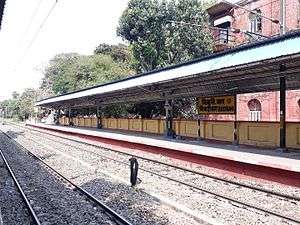 |
||
| 9 | Eden Gardens | ইডেন গার্ডেন্স | EDG | |||
| 10 | Prinsep Ghat | প্রিন্সেপ ঘাট | PPGT | 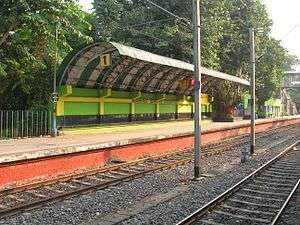 |
||
| 11 | Khiddirpur | খিদিরপুর | KIRP | |||
| 12 | Remount Road | রিমাউন্ট রোড | RMTR | – | ||
| 13 | Majerhat | মাঝেরহাট | MJT | 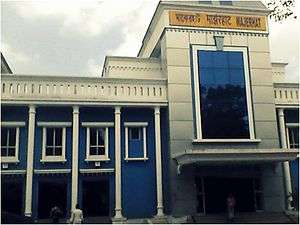 |
||
| 14 | New Alipore | নিউ আলিপুর | NACC | – | ||
| 15 | Tollygunge | টালিগঞ্জ | TLG | |||
| 16 | Lake Gardens | লেক গার্ডেন্স | LKF | – | ||
| 17 | Ballygunge | বালিগঞ্জ | BLN | 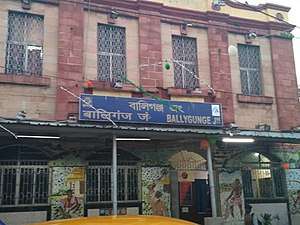 |
||
| 18 | Park Circus | পার্ক সার্কাস | PQS | |||
| 19 | Sir Gurudas Banerjee Halt | স্যার গুরুদাস ব্যানার্জি হল্ট | SGBA | |||
| 20 | Bidhannagar Road | বিধাননগর রোড | BNXR | 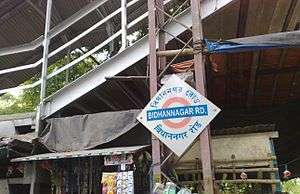 |
||
Trains with Extended Route
| Train Name | From | To | Daily Frequency |
|---|---|---|---|
| Canning-Barasat Local | Canning | Barasat | 3 |
| Bangaon - Canning Local | Bangaon | Canning | 1 |
| Champahati - Majerhat - Hasanabad Local (Via Tala) | Champahati | Hasnabad | 1 |
| Duttapukur - Ghutiary Sharrif (Via Dum Dum, Kolkata,Bagbazar,Khidirpur,Majerhat, Ballygunge And Gourdaha) Local | Duttapukur | Ghutiari Sharrif | 1 |
| Barasat - Majerhat Local (via - B.B.D. Bagh) | Barasat | Majerhat | 1 |
| Madhyamgram - Majerhat Local | Madhyamgram | Majerhat | 1 |
| Gede-Majerhat Local (Via Tala) | Gede | Majerhat | 1 |
Closure of airport extension
Kolkata's Circular Railway was extended from Dum Dum Cantonment to Biman Bandar/Netaji Subhash Chandra Bose International Airport. The 3.8 km (2.4 mi) extension from Dum Dum Cantonment station included two elevated stations Jessore Road and Biman Bandar. It ran at grade to UK Dutta Road and then on an elevated structure to the Airport passing through Jessop, Jessore Road, VIP Road and the domestic terminal road. This project was undertaken by the Kolkata Metro.
The Jessore Road station has been closed since 7 January 2015. The Biman Bandar station has been closed since 30 September 2016. Currently this section is being converted into metro under Kolkata Metro Line 4.[1]
Proposed stations
There is also a plan to build two more stations between Park Circus and Sir Gurudas Banerjee Halt named Tangra and Beliaghata Main Road respectively.
